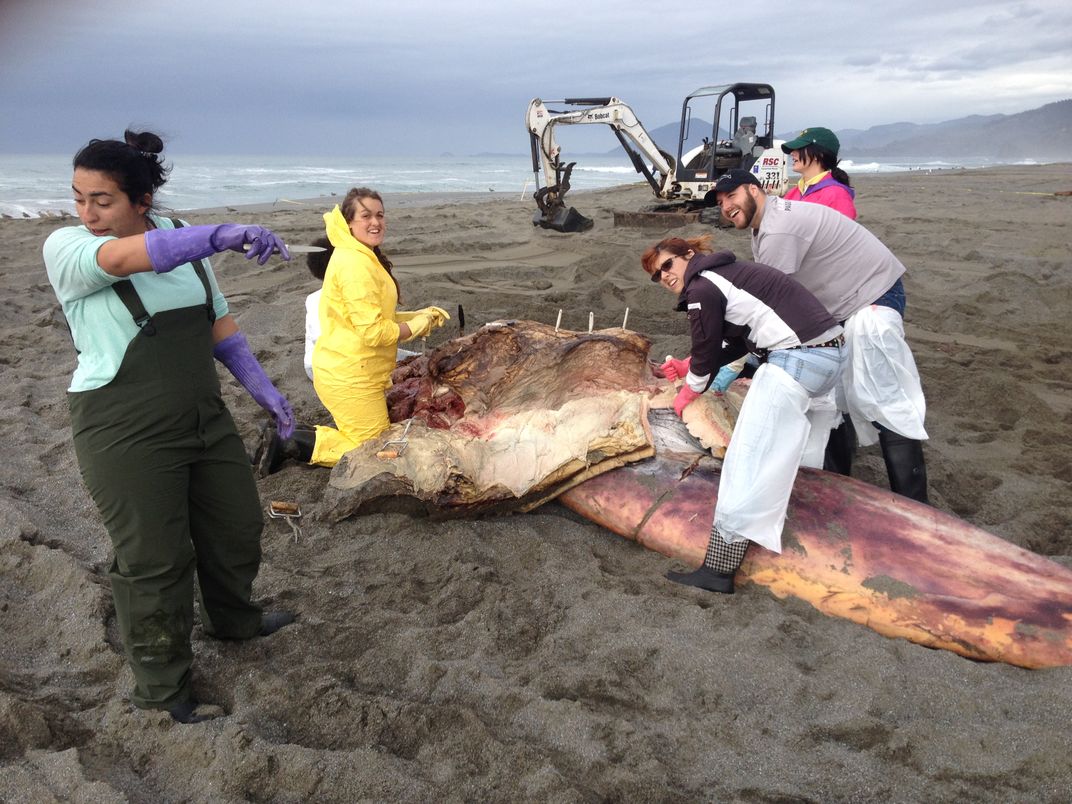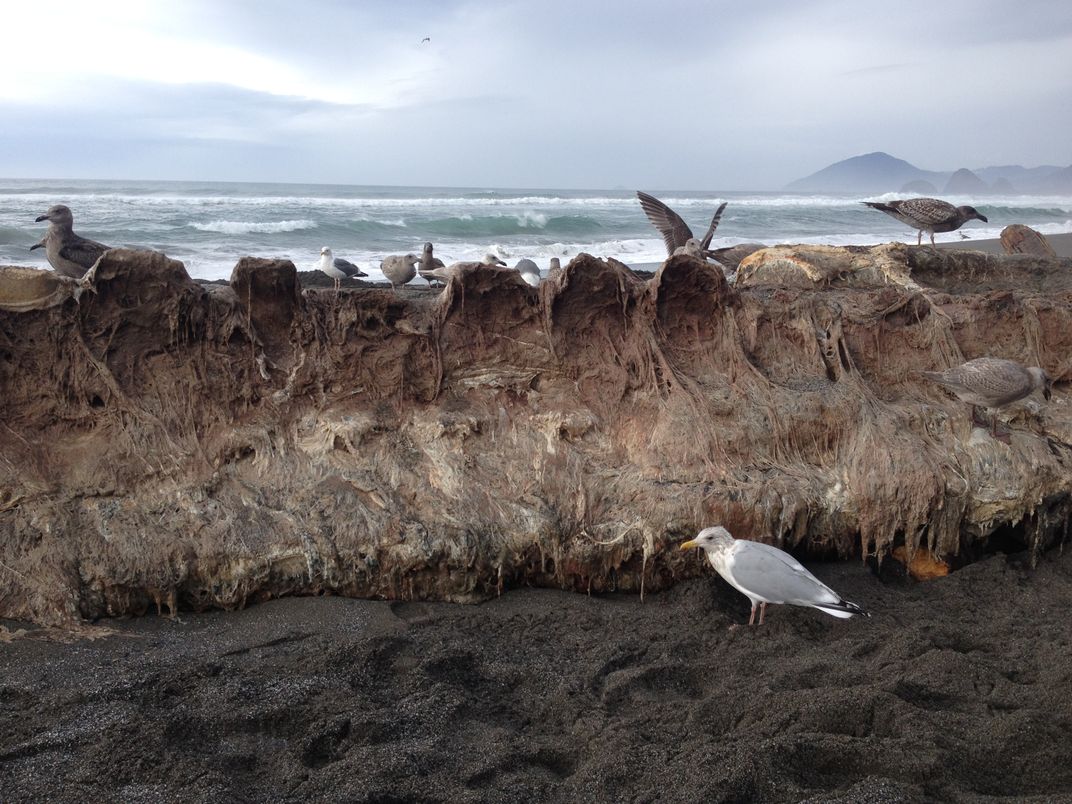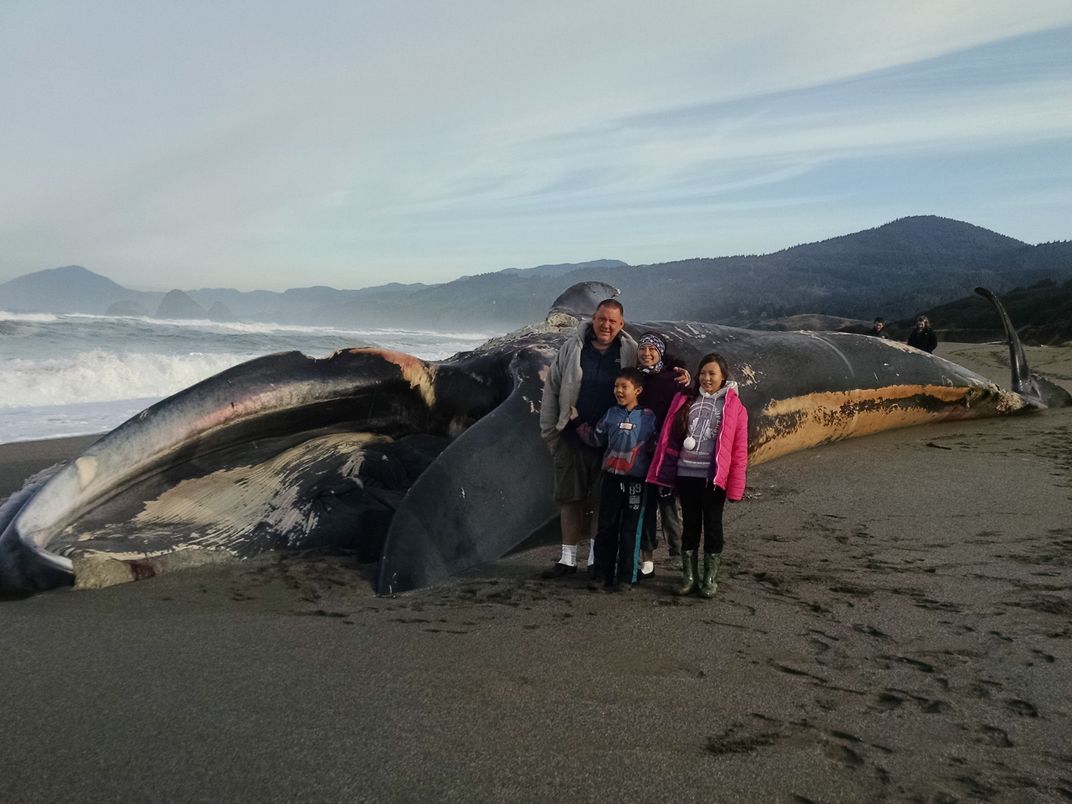What a Dead Blue Whale Can Teach Us About Life in the Ocean, and About Ourselves
Scientists and spectators gathered on an Oregon beach for the rare, messy, mesmerizing sight of a whale being carefully dismantled for museum display
/https://tf-cmsv2-smithsonianmag-media.s3.amazonaws.com/filer/8f/ec/8fec8095-7d2e-4fde-aeeb-48b65335fcbe/img_3855.jpg)
Standing on the blustery beach, Bruce Mate wears a camo slicker, green bibs, a tidy white beard and a somber expression. While Mate’s getup suggests a typical day in the field for a marine mammalogist, the box of latex gloves and bottle of chainsaw lubricating oil under his arm hint at this morning’s unusual task.
Behind Mate and a dozen students from Oregon State and Humboldt State universities, a dead blue whale stretches across southwestern Oregon’s Ophir Beach. The tide is still high on this bright November Saturday, and huge waves break against the cetacean’s sagging frame, sending up sprays of saltwater and scattering scavenging gulls into the air.
The behemoth corpse stranded here the previous Monday, November 2. As far as Mate knows, it’s the first recorded case of a blue whale washing up on the Oregon coast. The creatures are rare; perhaps 2,500 ply the eastern north Pacific, making up between 10 and 25 percent of the global population.
Because blue whales range over vast distances, they tend to sink far from shore when they die, seeding and sustaining a diverse ecosystem of creatures on the seafloor. For a carcass to drift within reach of human experts is the scientific equivalent of that bonanza, known as whale fall. A day after the stranding, Mate, who directs OSU’s Marine Mammal Institute in Newport, and OSU stranding coordinator Jim Rice were on scene with a mission: Extract the giant skeleton for public display.
“The preeminent concern here is your safety,” Mate says to the clustered students as they wait for the surf to retreat. “Be careful with knives. Use gloves. Respect the ocean. There can be sneaker waves”—unexpectedly large breakers that sweep high up the beach—“even when the tide’s out.”
“And it's good to wear eye protection, just in case ... ” one young woman adds, trailing off in a way that implies whale slime splatter is far from uncommon.
The project’s scale is overwhelming: The 70-foot whale weighs up to 100 tons and is half buried in sand. Money’s scarce, and the assembled tools are puny: There are three machete-like blades mounted on long wooden poles, called flensing knives, “a crap-ton” of kitchen knives, as one graduate student says, some meat hooks, some high-test rope and a chainsaw.
Even so, the crew managed to clear the whale’s right side down to the vertebrae by Friday night with help from a Bobcat mini-excavator and a track loader. Yellow “PROTECTED MARINE MAMMAL” caution tape flutters from driftwood stabbed into the sand around a wide perimeter. Volunteers smear Vicks VapoRub under their noses to hold back the stench—a throatier version of seashore rot that tastes like backwash from a mildew-darkened garbage disposal.

The Bobcat operator drops loads of the flensed blubber and muscle into a smoky fire at the bottom of a sandpit, but the crew has salvaged other parts. The racks of baleen that the whale used to filter food from seawater went to scientists hoping to test how oil in the water could affect whale foraging. And the whale’s eyeball will help researchers determine the animal's age based on specific proteins, information that may aid interpretations of its overall health.
Once the skeleton is mostly stripped, it will be moved to an undisclosed, sheltered location in the ocean, where it will take 12 to 18 months for bottom feeders to clean the bones completely. After they are sent to a degreasing company, the bones will be painstakingly mounted at the Hatfield Marine Science Center, where the Marine Mammal Institute is based.
Because of the whale’s advanced state of decay, most of the other internal organs are scientifically worthless, and definitively determining the cause of death will be impossible. Still, there are clues.
“On the tail fluke, see those squiggly lines? Those are killer whale tooth marks,” Rice says, then points out a chunk of flesh missing from the whale’s jaw. “Whether the attack was lethal is hard to say, but it’s well-documented that killer whales will kill large whales. They hunt them down like wolves and prevent them from surfacing to breathe.” There are also signs of scavenging by sharks.
But the blubber is most worrisome, Mate says: It’s a third the thickness it should be at this time of year, suggesting the whale was starving. He suspects that unusually warm ocean temperatures along the West Coast over the last two years haven’t favored the growth of blue whales’ staple food source: a tiny crustacean called krill.
With a super El Niño threatening to compound the problem this year, “I worry for the rest of the population,” says Mate, who pioneered satellite tracking of large whales, including 200 blues. “I don't think we'll see calves born for another three years. Maybe longer.”

Frigid rain starts in earnest by early afternoon, but the volunteers keep at it, some donning red ponchos that, cinched at the waist with duct tape, flare out like skirts. By the fire, one group works on the whale’s pectoral fin and shoulder, slowly revealing a coffee table-sized scapula.
Another team laboriously divides the carcass into six- to eight-foot lengths from the tail end up, using the flensing knives to saw between tire-sized vertebrae and down through the muscle and blubber on the still-buried side of the whale so that the track loader can tow them up the beach.
The meat that remains is slack, greenish and stringy. I ask the volunteers why they’d want to be elbow deep in such a mess. For most, the answer is simple: It’s the chance of a lifetime.
“When you feel overwhelmed or you feel like you’re going to vomit,” explains OSU master’s student Natalie Mastick, “you remember that you’re touching the largest whale in the world.”
Those I speak to among the dozens of spectators on the other side of the yellow tape say much the same thing: When else would they see a blue whale in such close detail? The visitors groan with horror and fascination as the Bobcat tears away the whale’s massive, springy tongue. They share stories of other strandings they’ve seen: a fleet of sperm whales, a gray whale not far from here, a seal with a bite out of it as big as the span of a child’s arms. The gathering is part morbid voyeurism, part wonder and part cataloguing of loss.
A local family, still dressed up from a bible meeting, surveys the fray from the road. “I’ve never seen so many people on this beach,” says the mother, a woman with dark hair named Angel Bacon. The Bacons visited the whale early in the week, when it was still alone and intact. “It felt soft and smooth,” says Bacon’s 12-year-old daughter Malaika, lifting her hand as if touching it again. “Like a newborn baby.”

Back at the whale, I learn that the volunteers have discovered a massive skull fracture. Mastick points out a crack clear through three-inch bone, and she and another volunteer pull out shards the size of dinner plates. That kind of force, Mate speculates, could probably only have come from a ship strike that caused or happened after the whale’s death.
It’s twilight when OSU undergraduate David Culp asks whether I’ve touched the whale. I say no and he passes me a pair of gloves. Stepping carefully up to the twisted body, I lay my palm on the peeling black skin of the lower jaw.
I expect it to be as hard as the graceful arch of bone it encases. But instead, the thin flesh gives a little, reminding me how recently this creature still drew breath and explored deep, dark places I can only imagine. I leave my hand there for a long time.
/https://tf-cmsv2-smithsonianmag-media.s3.amazonaws.com/accounts/headshot/gilman-headshot.jpg)
/https://tf-cmsv2-smithsonianmag-media.s3.amazonaws.com/accounts/headshot/gilman-headshot.jpg)